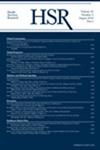Association of Hospitals' Experience with Bundled Payment for Care Improvement Model with the Diffusion of Acute Hospital Care at Home
Abstract
Objective
To examine whether hospitals' experience in a prior payment model incentivizing care coordination is associated with their decision to adopt a new payment program for a care delivery innovation.
Data Sources
Data were sourced from Medicare fee-for-service claims in 2017, the list of participants in Bundled Payment for Care Improvement initiatives (BPCI and BPCI-Advanced), the list of hospitals approved for Acute Hospital Care at Home (AHCaH) between November 2020 and August 2022, and the American Hospital Association Survey.
Study Design
Retrospective cohort study. Hospitals' adoption of AHCaH was measured as a function of hospitals' BPCI experiences. Hospitals' BPCI experiences were categorized into five mutually exclusive groups: (1) direct BPCI participation, (2) indirect participation through physician group practices (PGPs) after dropout, (3) indirect participation through PGPs only, (4) dropout only, and (5) no BPCI exposure.
Data Collection/Extraction Methods
All data are derived from pre-existing sources. General acute hospitals eligible for both BPCI initiatives and AHCaH are included.
Principal Findings
Of 3248 hospitals included in the sample, 7% adopted AHCaH as of August 2022. Hospitals with direct BPCI experience had the highest adoption rate (17.7%), followed by those with indirect participation through BPCI physicians after dropout (11.8%), while those with no exposure to BPCI were least likely to participate (3.2%). Hospitals that adopted AHCaH were more likely to be located in communities where more peer hospitals participated in the program (median 10.8% vs. 0%). After controlling for covariates, the association of the adoption of AHCaH with indirect participation through physicians after dropout was as strong as with early BPCI adopter hospitals (average marginal effect: 5.9 vs. 6.2 pp, p < 0.05), but the other categories were not.
Conclusions
Hospitals that participated in the bundled payment model either directly or indirectly PGPs were more likely to adopt a care delivery innovation requiring similar competence in the next period.

 求助内容:
求助内容: 应助结果提醒方式:
应助结果提醒方式:


